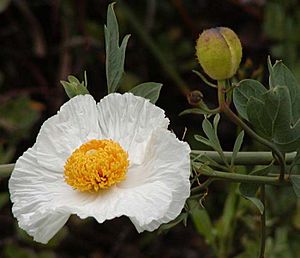Matilija poppy facts for kids
Quick facts for kids Matilija poppy |
|
|---|---|
 |
|
| Matilija poppy flower and flower bud. | |
| Scientific classification |
|
| Kingdom: | Plantae |
| Clade: | Tracheophytes |
| Clade: | Angiosperms |
| Clade: | Eudicots |
| Order: | Ranunculales |
| Family: | Papaveraceae |
| Subfamily: | Papaveroideae |
| Tribe: | Papavereae |
| Genus: | Romneya Harv. |
| Species | |
Romneya is a group of beautiful flowering plants in the poppy family. This family is called Papaveraceae. These plants are often called Matilija poppies (say it: muh-TIL-i-hah) or tree poppies. They grow naturally in California and northern Mexico. There are two types, or species, of Romneya. The group was named after an Irish astronomer, John Thomas Romney Robinson.
Contents
About Matilija Poppies
Matilija poppies are perennial subshrubs. This means they are like small bushes with woody stems that live for many years. They can grow quite tall, up to about 2.5 meters (8 feet) high. They can also spread out to about 1 meter (39 inches) wide.
What They Look Like
The flowers of the Matilija poppy are very large and striking. They can be up to 13 centimeters (5 inches) across! They have big, white petals and bright yellow centers. People sometimes call them the "fried egg flower" because of their look. The leaves are a pretty silvery-green color. They are deeply cut, almost like a fern, and have tiny hairs along their edges.
Where and How They Grow
Matilija poppies love warm, sunny places. They grow best in soil that is rich and drains water well. These plants can be a bit tricky to start growing. But once they are settled, they are very strong and hard to remove.
In the wild, Matilija poppies are known as "fire followers." This means they often grow in areas that have recently had a wildfire. They are not only found in burned areas, but they are quite common there.

Types of Matilija Poppies
There are two main species of Matilija poppies:
- Romneya coulteri – This is known as Coulter's Matilija poppy.
- Romneya trichocalyx – This is called Bristly Matilija poppy. Some people think this is just a type of Romneya coulteri. However, many plant experts now agree it is its own species.
See also
 In Spanish: Amapola blanca para niños
In Spanish: Amapola blanca para niños

